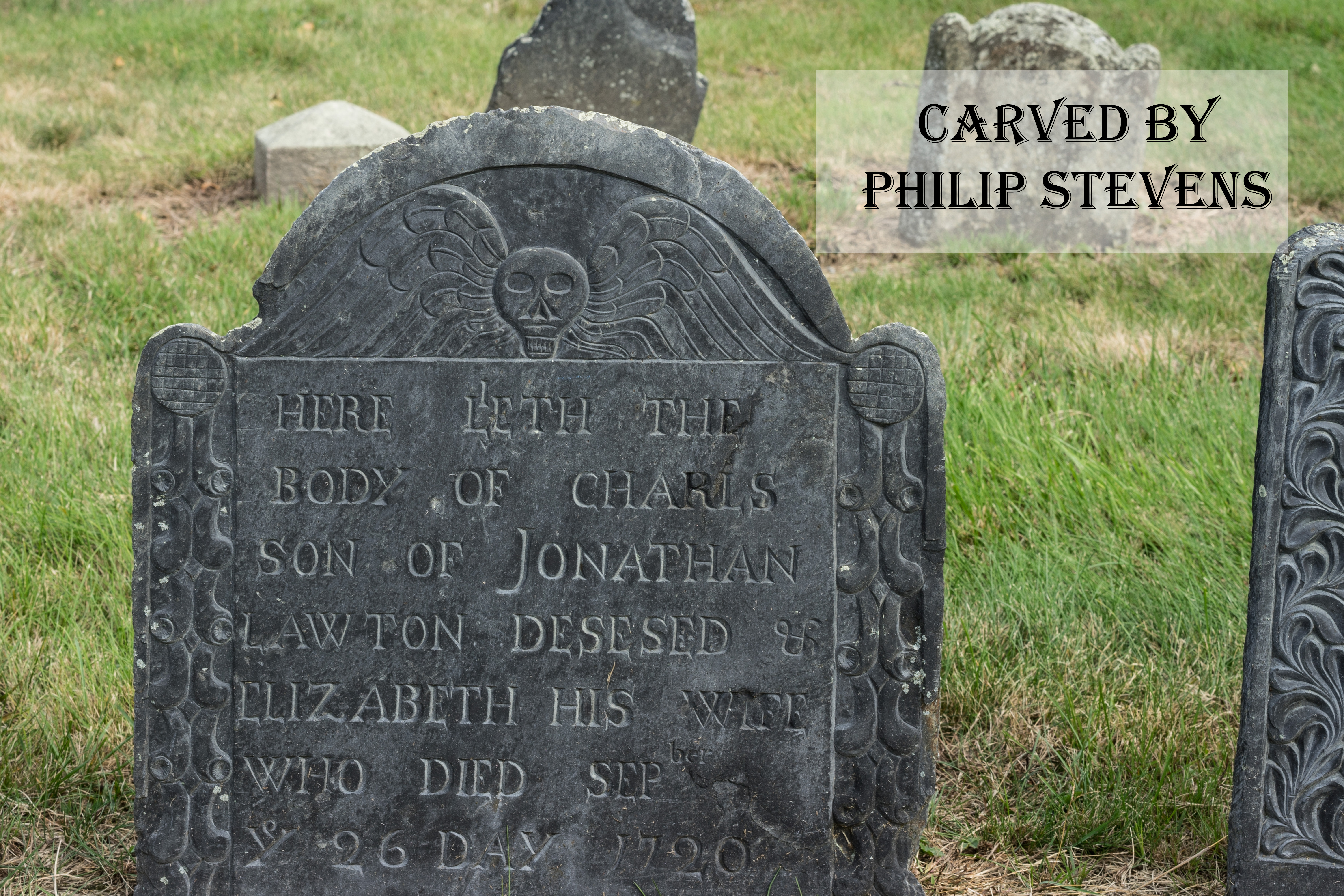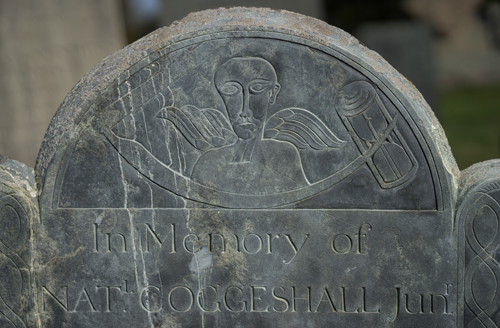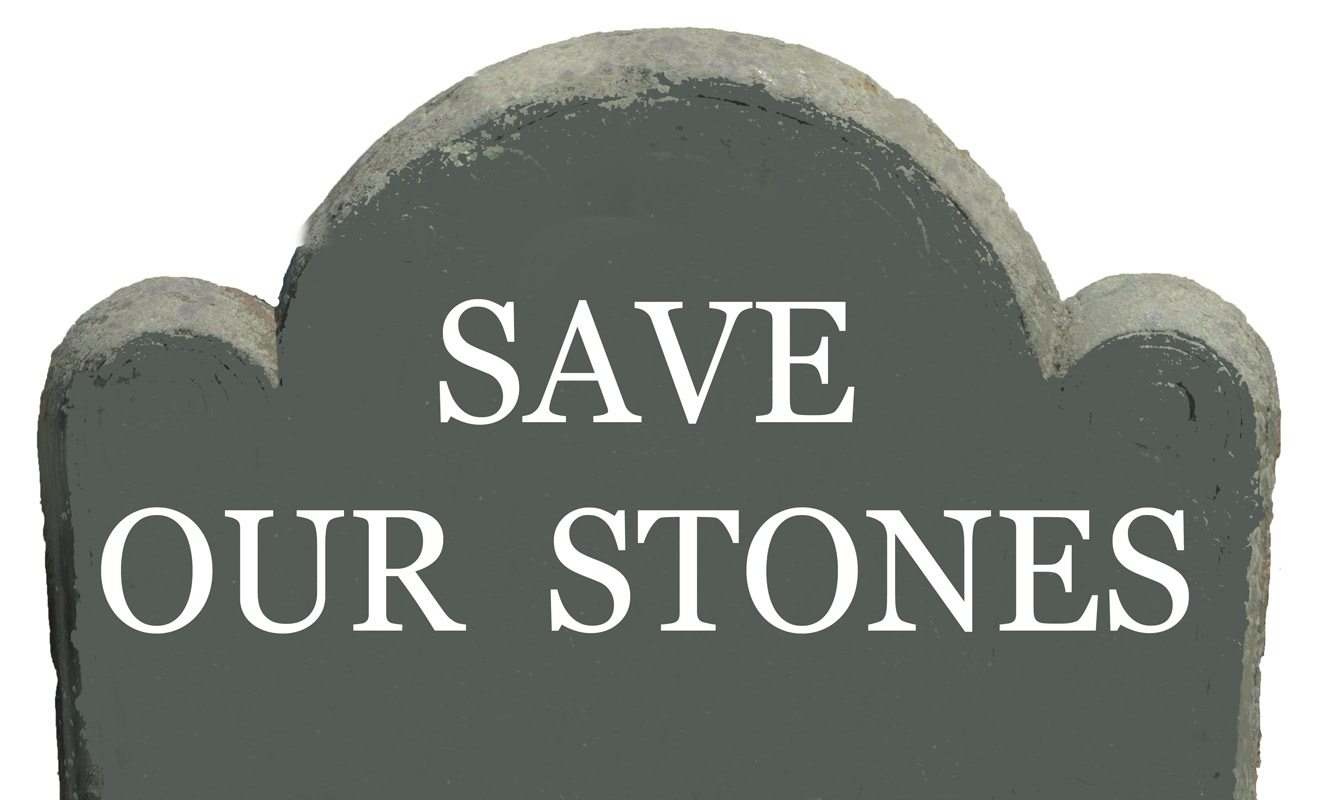The earliest carved gravestones in Newport were done by an unidentified person who, due to the design, is referred to as the Spiral Carver. His work can be seen in stones for Mary Cranston (1666), Joseph Cranston (1669), John Piner (1670), and Elizabeth Baily (1672)

A gifted carver from the Boston area, William Mumford (1641-1718), has many exquisitely carved stones in Newport dating between 1685 and 1700. He trained Nathaniel Emmes, father of carver Henry Emmes and was active in the Boston area. Mumford married Ruth Copp whose family land evolved into Copp's Hill burying ground.
 Newport's first known stone carver was John Stevens who arrived and established a stone carving business in 1705. The Stevens family carved stones for six generations and the shop continues to this day under the care of the Benson family (since 1927).
Newport's first known stone carver was John Stevens who arrived and established a stone carving business in 1705. The Stevens family carved stones for six generations and the shop continues to this day under the care of the Benson family (since 1927).
John I, John II, and John III carved at at 30 Thames Street (top picture)
Later generations of the Steven's family and the Benson family carved at 29 Thames Street (bottom picture)

Luti has information about the Stevens shop and properties. Linked here is a document that focuses on the ownership of 30 Thames Street.
John Stevens I (1645-1736)
John arrived in Newport in 1705. He was 50 years old, recently married and needed to provide for his growing family. Primarily a mason, his early stone work is more etched than sculptural (left picture below). It is believed that a carver from the Boston area arrived and provided training for John and at least one of his sons. His stonework dramatically improves (right image below) and his imagery begins to form the basis of the Stevens design used by generations of carvers. In 1724 at age 79, John turned the business to his first son, twenty-two year old John Stevens II.
John II (1702-1778)
John Stevens II, like his father, was primarily a mason. In addition to the numerous foundations, and fireplaces he also worked on major buildings including the Redwood Library and Touro Synagogue. When he became head of the family business he also assumed the responsibility of caring for his parents and younger siblings. In a divided city as revolution neared, John II was viewed as a patriot.
As a stone carver, John II would have been 13 to 18 when the Boston teacher was here and most likely, have been trained to carve. His style matures and solidifies the Stevens style of carving that features a front facing bald soul effigy with wings carved in black flinty slate. John II bought 29 Thames about 1757 but lived and worked at 30 Thames. It is likely his widowed sister, Martha Bissel, lived at 29 for a time before this became the current Stevens Shop location.


Phillip Stevens (1706-1736)
The second son of John Stevens, Phillip, had a carving style very much like the Boston teacher that arrived in Newport and instructed his father. While there is no record supporting the idea that he was trained by the Boston carver, the similarities in the work of the two men supports the idea that this is true. Stones carved by Phillip are masterfully carved and he was, perhaps the best carver in the family. Sadly his life was cut short when he died in 1736. A notation in the ledger of John II simply states that Phillip was murdered.

James Stevens (1708-1765)
As the third son of John Stevens, James knew he would not inherit the family business and needed to embark on a different career. Like some of his brothers, James took to the sea for a living and made it the focus of his life as a merchant sea captain. While on shore he did carve gravestones but they are not as numerous or as finely done as the work of his three other brothers. James was a founding member of the United Brethren Society in Newport. When he drowned at sea, he willed his possessions to his wife, his brother William, but not his brother John.

William Stevens (1710-1790)
The youngest of the Stevens sons, William would grow up and undertake a variety of occupations including seaman, merchant, and stone carver. Of all the Stevens carvers, William is credited with carving the most number of stones. His marriage to Ann Bull would result in his connection to his brother-in-law, John Bull, who would become first his indentured servant and apprentice and later his rival. William moved to Philadelphia during the revolution where it is believed he died and is buried.
His carving style, while similar to his father's and brother John, would evolved into his own. Wigged effigies are most often attributed to William and he is the only carver to etch eyelashes on his stones.

John Bull (1734-1808)
When his older brother mishandled the family finances, John Bull was contracted to indentured servitude to his brother-in-law William Stevens in 1747. William trained John to be a stone carver. The two men did not get along and John Bull left Newport for years to earn his living at sea. When he did return to Newport he returned to carving gravestones. William sued John for breaking his contract and the court would eventually find in John's favor. He would marry and raise his family in Middletown, RI. By the end of his life John was blind but financially secure.
As a carver, John's early work resembles the work of William, his teacher. As his style matures he becomes Newport's most artistic carver. In addition to the typical Stevens images, John produced a signature side facing effigy framed by a scythe and hourglass. He carved some of the most creative stones in the city including the Bardin stone with it's biblical theme and the Tripp stone that includes her buried arm. The six humped stone for the deceased Langley children with side facing effigies (cherubs) is a remarkable carving.


Pompe Stevens
Pompe is another carver with links to William Stevens as he was enslaved in his service. This African carver signed two of the stones in God's Little Acre and his hand most likely helped create numerous other stones for William. Other than the signatures on the stones and the link to William, the only other information we know is that Cuffee Gibbs was his brother ( as stated on the stone he carved)
Use this link for more information about Pompe.
John Stevens III (1753-1817)
John III, the grandson of the founder and son of John II and the first family member to view himself primarily as an artist. This educated young man was not a mason like his father or grandfather. His early stones resemble his father's style but John will later use the side facing effigy as did John Bull. He also carved images for people of African heritage that some view as having more appropriate facial features than stones displaying European features. During his carving career, John III signed his stones, something the other family members did not do.
John's son Phillip (great-grandson to the founder) and Phillips sons, Lysander and Edwin (great great grandsons to the founders), and Phillip III, great-great-great-grandson would continue the Stevens carving tradition. As styles changed and machines entered the carving business, the work of the later generations is not considered as significant as the work of the family members who preceded them.
stones carved by John Stevens III
Use this link to a summary chart of grave stone carvers in colonial Newport







